|
|
Dell Pro Rugged 14
Dell's full-size, high-performance, semi-rugged AI PC gets a new name, new tech, and you can get it with an optional NVIDIA's RTX 500 Ada Generation laptop GPU
(by Conrad H. Blickenstorfer -- photography by Carol Cotton)
The Dell Pro Rugged 14 first appeared in Dell literature on October 18, 2024 in the company's Dell Rugged Laptops, Tablets & Accessories brochure, almost exactly three years after its predecessor — the Dell Latitude 5430 Rugged — was introduced in a Dell Blog entry by Tom Tobul, who is now Vice President, Commercial Notebooks. Back then, Tobul described the platform as machines "designed for applications that require excellent field durability combined with optimal performance." And that has not changed, as the Dell Pro Rugged 14 is clearly the technologically updated and functionally enhanced successor of the Latitude 5430 Rugged.
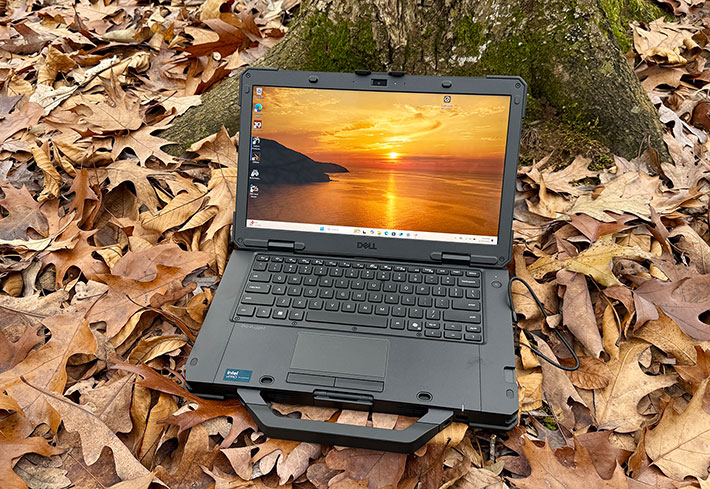
More recently, on November 25, 2024, Dell published the informative and well done "Exploring New Rugged PCs Built for Extreme Performance" video where Dell's Cara Bernstein and Steven Cook presented the Dell Pro Rugged 13 and 14. The duo, the 13 fully rugged and the 14 semi-rugged, are visually virtually unchanged from their predecessors, and thus remain compatible with all of the predecessor laptops' adds-on and accessories. So, unlike the step up from the 5420 to the 5430, which brought substantial redesign, with the new models it's largely new tech. We're talking a three-generation jump in processors as well as substantial upgrades in graphics and communications.
Dell Pro Rugged 14 positioning
Right upfront, just to avoid as much confusion as we can: While Dell's two new heavy-duty machines both just have "Rugged" in their names now instead of the former "rugged" and "rugged extreme", by generally accepted nomenclature the Dell Pro Rugged 14 is a semi-rugged laptop and the Dell Pro Rugged 13 a fully rugged laptop. 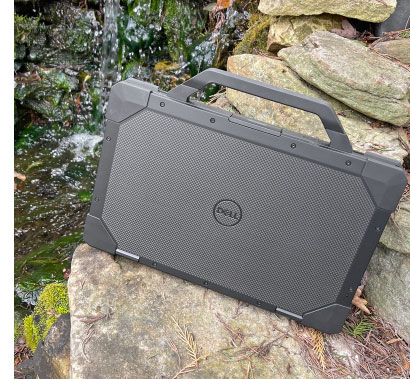 Yes, "semi-rugged" remains an awkward term and perhaps that's why Dell now calls both of the new machines just "rugged," like some of the competition is now doing as well. "Semi-rugged" was never clearly defined; it was simply used to describe a device that's more durable than your average consumer laptop or even corporate notebook computer, but without going to extremes. What do we mean by extremes? Well, you get get the basic (semi-rugged) Dell Pro Rugged 14 at under US$2,000 whereas the Dell Pro Rugged 13 starts at $4,100, more than twice as much. Yes, "semi-rugged" remains an awkward term and perhaps that's why Dell now calls both of the new machines just "rugged," like some of the competition is now doing as well. "Semi-rugged" was never clearly defined; it was simply used to describe a device that's more durable than your average consumer laptop or even corporate notebook computer, but without going to extremes. What do we mean by extremes? Well, you get get the basic (semi-rugged) Dell Pro Rugged 14 at under US$2,000 whereas the Dell Pro Rugged 13 starts at $4,100, more than twice as much.
Why a "semi-rugged" in the first place? In essence, you want one if your computer spends more time outdoors and on the road than back in the office. Semi-ruggeds must be spill-proof because they may encounter rain, they must be able to handle vibration because they'll spend time in vehicles, and their screens must be viewable and usable outdoors and in bright sunshine. They must be fast and powerful enough to get all the work done, they must have enough battery life to make it through the day, they must have all the ports you need, and they must be light and handy enough to go anywhere.
One look at the Dell Pro Rugged 14 and you know this is no standard consumer laptop. It looks tough and purposeful. It has an integrated handle to carry it around without needing to bring a bag along. All of the computer's interface ports — and it has quite a few of those — have individual protective covers to guard against damage. This is a machine that you don't have to baby; It is in the SUV class of laptops and it can take a bump or two. You can take them off-road, just not as far as dedicated military-grade vehicles.
New versus old, what does all this amount to? The big deal is the new technology under the hood. By now, the outgoing Latitude 5430 Rugged is three full Intel processor generations behind. While that made and makes the 5430 by no means obsolete, processor technology advances very quickly and Dell was in danger of being left behind by the competition, most of which is technologically up-to-date and at the state-of-the-art. The new Dell Pro Rugged 14 fixes all that. The below table shows the relevant specs of the line that began with the 5420 in 2018, was then updated to the 5430 in 2021, and has now become the Pro Rugged 14. Compared to its predecessor, at first glance and even at second and third, this new semi-rugged Dell looks on the outside virtually identical to the previous one. And yet it has been changed and improved in many ways.
|
Dell
|
Pro Rugged 14
|
5430 Rugged
|
5420 Rugged
|
|
Introduced
|
2024
|
2021
|
2018
|
|
Standard display
|
14.0", 1920 x 1080 (157 ppi)
|
14.0", 1920 x 1080 (157 ppi)
|
14.0", 1920 x 1080 (157 ppi)
|
|
Optional screen
|
Capacitive touch, 1100 nits
|
Capacitive touch, 1100 nits
|
Capacitive touch 1000 nits
|
|
Dimensions
|
13.38 x 8.66 x 1.32 inches
|
13.38 x 8.66 x 1.32 inches
|
13.66 x 9.65 x 1.3 inches
|
|
Discrete graphics
|
Yes; NVIDIA RTX 500
|
Yes; NVIDIA T500
|
Yes; Radeon
|
|
Weight
|
From 4.49 pounds
|
From 4.35 pounds
|
From 4.90 pounds
|
|
Processors
|
Intel 14th gen Core
|
Intel 11th gen Core
|
Intel 6th/7th/8th gen Core
|
|
Battery
|
1 or 2 x 53.5Wh Li-Ion
|
1 or 2 x 53.5Wh Li-Ion
|
1 or 2 x 51Wh Li-Ion
|
|
Memory
|
Max 64GB DDR5 5600MHz
|
Max 32GB DDR4 3200MHz
|
Max 32GB DDR4 2400MHz
|
|
Max storage
|
2TB PCIe SSD
|
2TB PCIe SSD
|
2TB PCIe SSD
|
|
Media bay
|
No
|
No
|
No
|
|
Windows Hello
|
Yes
|
Yes
|
Yes
|
|
USB Type-C
|
Yes
|
Yes
|
Yes
|
|
Thunderbolt 4
|
Yes
|
Yes
|
No
|
|
Sealing
|
IP53
|
IP53
|
IP52
|
|
Drop
|
3-foot operating
|
3-foot operating
|
3-foot operating
|
|
Op. temp range
|
-20° to 145°F
|
-20° to 145°F
|
-20° to 145°F
|

Now let's quickly recap Dell's history and experience in ruggedized laptops. Starting around 2007, Dell began offering ATG semi-rugged and XFR fully rugged notebooks. ATG stood for "All Terrain Grade" and XFR for "Xtreme Fully Rugged." The XFR models were originally made for Dell by Augmentix, a company which later became part of Dell. In early 2014, Dell replaced the XFR with the Latitude 12 Rugged Extreme convertible and the Latitude 14 Rugged Extreme laptop, and the ATG gave way to the Latitude 14 Rugged. That marked the start of Dell's semi-rugged "Latitude Rugged" and fully-rugged "Latitude Rugged Extreme" models.
Dell used to say that whereas the old ATG semi-rugged laptops were built "up" from standard Latitude commercial versions, the Latitude 14 Rugged models were built "down" from the Rugged Extreme line. As we shall see, that still seems to be the case. There is a big difference in look, design, weight and robustness between Dell's standard business and enterprise laptops and any of the rugged models. Rugged labelled machines on the other hand, while very different in terms of toughness and protection, look almost the same.
In terms of competition, the Dell Pro 14 Rugged is squarely aimed at Panasonic's Toughbook 55, Getac's S410, the Durabook S14I and similar. There are also several Taiwan- and China-based OEMs whose durable and semi-ruggeds circulate under various brand names and sometimes also their own.
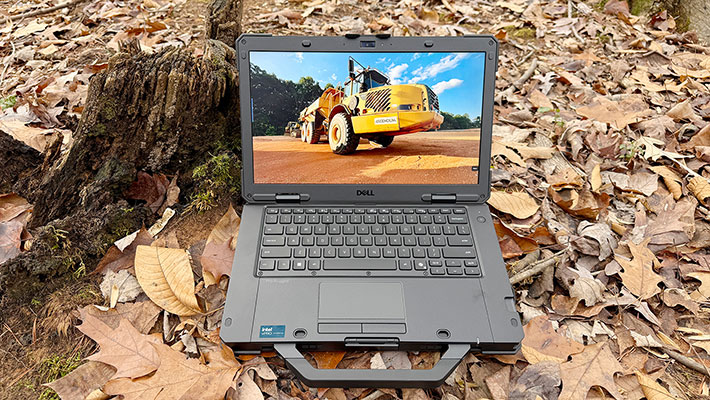
Design and construction
Dell has always done a fine job visually differentiating their rugged mobile computers from more consumer and enterprise oriented platforms, all the while creating a crisp and elegant look. Dell rugged gear isn't generally as overtly aggressive as some of the competition's — the company prefers to emphasize understated competence instead. But the Dell Rugged laptops also feel tough and solid, leaving no doubt that these are heavy-duty computing machines that can do what no standard consumer or even business laptop could tackle.
But let's take a closer look at the Dell Pro 14 Rugged. Below you can see the top and all four sides of the machine:
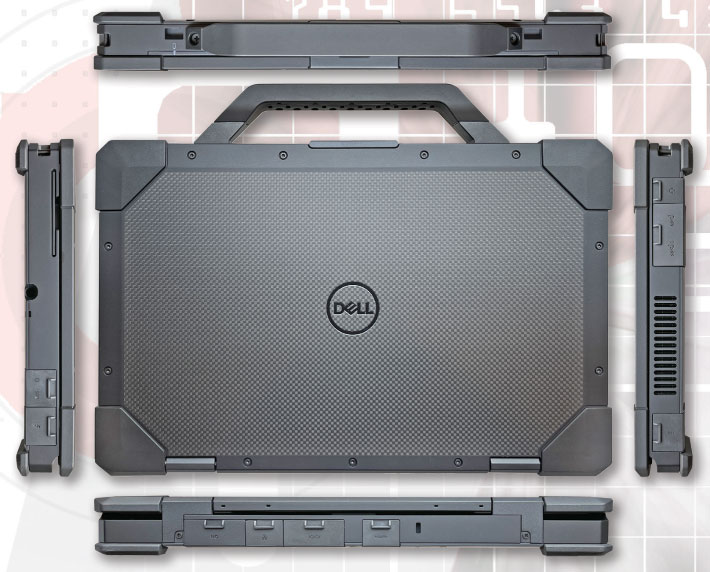
Ports and connectivity are all around the housing, excluding the front which is where the optional sturdy, well-designed fixed-mount carry handle goes. To guard against physical damage, all ports are located behind protective doors. Those port covers are simpler than on the Dell Pro 13 Rugged and they are not designed to seal against dust and liquids. Instead of the 13-inch model's port covers with spring-loaded levers and locking sliders, the ones on the Dell Pro 14 Rugged need to be properly seated and then pushed into place, which still requires a bit more attention than we'd like.
As far as wired connectivity goes, the Dell Pro 14 Rugged offers plenty.
Along the backside (shown below with protective port covers removed for better viewing) are from left to right:
- An optional I/O bay with USB 3.2 Gen 1 port (OR native serial OR Fischer USB)
- An RJ45 gigabit LAN jack
- A DB9 RS232 serial port (OR DisPlayPort OR DB15 VGA port)
- A standard HDMI port to connect a monitor
- A Kensington lock slot

On the left side (shown below, again with protective port covers removed) you can see from left to right:
- A Thunderbolt 4/USB 3.2 Gen 2 Type-C port with PowerDelivery 3.0
- A USB 3.2 Gen 1 port with PowerShare
- A USB 3.2 Gen 1 port
- A 3.5mm combo headphone & microphone jack

On the right side (shown below, with protective port covers removed) you can see from left to right:
- An optional Smart Card reader
- An optional stylus slot
- A SDXC card slot
- A Nano SIM card slot
- An optional Thunderbolt 4/USB 3.2 Gen 2 Type-C port with PowerDelivery 3.0

What all of that means is that with the new Pro 14 Rugged, Dell now has a "semi-rugged" laptop with completely updated technology under the hood. And, as well see, one that with its new processors is ready for entry into the emerging AI world and economy.
A look inside the Dell Pro Rugged 14
Opening up a Dell Pro Rugged 14 is a treat for aficionados of great electronics design. Not because it is a challenge to disassemble this impressive laptop — undo a couple of dozen small Phillips screws and (very) carefully disconnect a couple of (short) cable strands — but because of what you find inside. 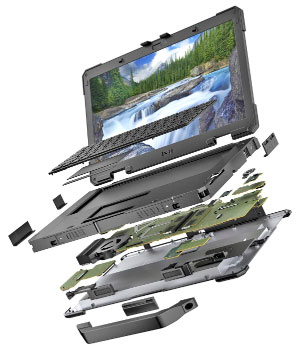 In an era where most laptop housings are as sleek and slender as they can be made without breaking almost right away, this reasonably priced semi-rugged Dell surprises with an all-magnesium aluminum housing that represents good industrial design at its best. In an era where most laptop housings are as sleek and slender as they can be made without breaking almost right away, this reasonably priced semi-rugged Dell surprises with an all-magnesium aluminum housing that represents good industrial design at its best.
And it's not just a box with a couple of boards mounted inside. Dell went all out here to design this machine as an integral whole. Both the front and the back half of the case are fine example of the form-follows-function approach.
Nothing is just glued or tacked on. Almost every wire has its own wire guide, every module is securely mounted in its specially designed place, and every ribbon cable is individually sized to fit just so. What needs to be shielded is shielded with whatever material that gets the job done. Dozens of small 2D barcodes mark purpose, identity and origin of every component. And wherever Dell's designers and engineers saw an opportunity to add functionality, better cooling, extra rigidity, some small weight saving into the case and everywhere else, they did it.
The degree of detail is stunning is everywhere. Here's an example: rugged computers must have those protective covers over I/O ports to keep them from getting damaged and to keep dust and water from getting inside the computer. That's often done with just a couple of rubber plugs. This Dell laptop, on the other hand, has NINE individual protective covers, each a different design, each separately mounted, each able to move just the right amount, and each perfectly integrated into the metal housing.
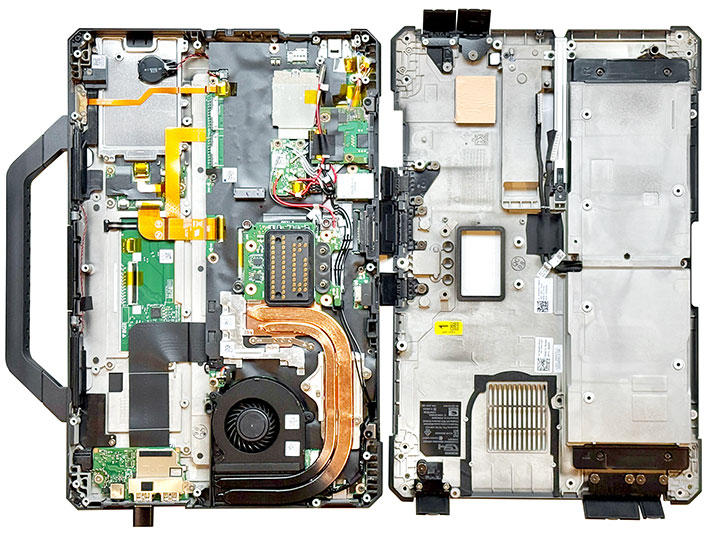
Thermal management is equally impressive. As is generally the case these days with rugged laptops, the Dell Pro Rugged 14 has a small fan. It also has two prominent copper heat pipes that channel the heat generated by the processor and other electronics to the heat exchanger cooled by the fan. Between that and the solid metal case of the laptop, overheating should never be an issue. But just to make extra-sure, wherever there is a small part or component that might get hot, Dell applied a thermal strip that then conducts the heat on to a metal heatsink.
The image below was taken while our two Dell Pro Rugged 14 review units were running performance benchmarks with one of our FLIR thermal cameras that visually depict surface temperature. The test units were identical with one exception. The laptop on the right in the picture has the optional NVIDIA RTX 500 graphics chip and uses a higher wattage power supply, and that accounts for the higher running temperature.
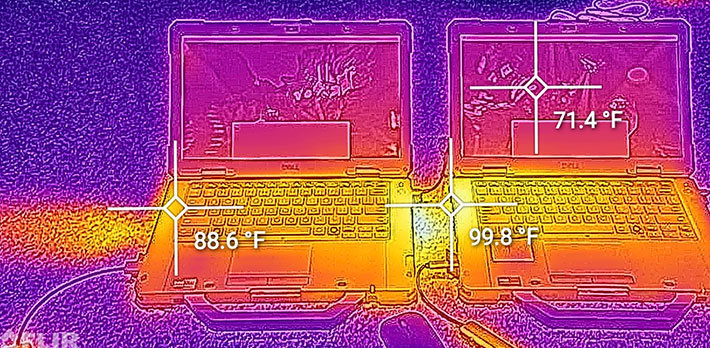
A fan, of course, requires an air intake and an air exhaust, and that means openings to the inside of the computer. That is an additional design and engineering challenge for fully rugged laptops that carry IP65 ingress protection ratings and higher, meaning they are pretty much fully sealed against the elements. Such "fully-rugged" designs do that by placing a water-proof fan inside its own compartment, separate from all the electronics. The Dell Pro Rugged 14, though it has "Rugged" in its model name, is what we used to call a "semi-rugged" design — sturdy and very well built, but with a somewhat lower and less costly level of sealing. The Dell Pro Rugged 14 carries an IP53 ingress protection rating, which is currently the standard in this class. It means a device doesn't mind a bit of rain or so, but it cann't handle immersion or sitting in a puddle of water.
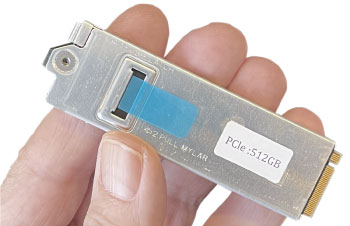 The sealing level is actually one of the big differences between the 14-inch Dell Pro Rugged 14 and the 13-inch Dell Pro Rugged 13 (which used to be called the Latitude 7330 Rugged Extreme). Dell probably COULD have encapsulated the fan in the 14-inch model as well, but that would have raised the cost considerably. The sealing level is actually one of the big differences between the 14-inch Dell Pro Rugged 14 and the 13-inch Dell Pro Rugged 13 (which used to be called the Latitude 7330 Rugged Extreme). Dell probably COULD have encapsulated the fan in the 14-inch model as well, but that would have raised the cost considerably.
And speaking of that line between rugged and fully-rugged, the port covers are another major difference between the two models. The Rugged 14's are made of hard rubber and mostly guard against physical damage of the ports. The (fully-)rugged 13-inch model's are significantly more elaborate and also guard against liquids getting inside.
The image to the right shows the Dell Pro Rugged 14's PCIe NVMe storage module. The space saved by dropping the old 2-1/2 inch mass storage bays in these kinds of laptops in favor of smaller and much faster PCIe NVMe storage is substantial. And it's also much easier to quickly remove these storage modules, which has become a security requirement by many agencies and organizations.
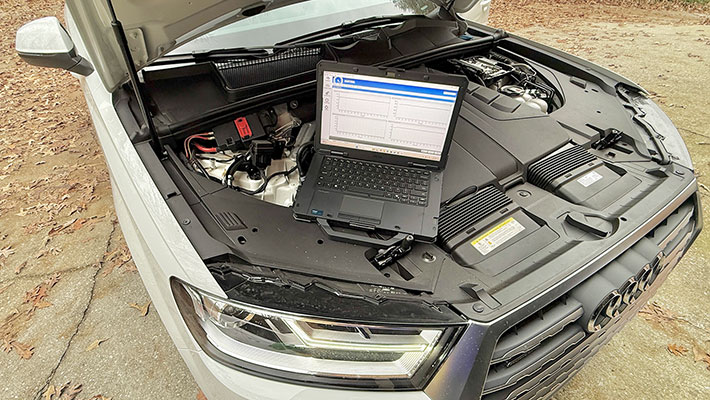
Keyboard and hardware controls
A solid, well-designed and well-functioning keyboard is crucial in a laptop. If the keyboard isn't up to par, one might as well use a tablet. Dell, of course, has decades' worth of experience in getting laptop keyboards just right, and that shows in the Dell Pro Rugged 14.
What customers are getting here is island-style keyboard perfection. That starts with a "full-scale" layout of the all important alpha keys. The distance from the center of the letter Q on the upper lefthand and the center of the letter P on the upper righthand of the alphabet key layout is exactly 6.75 inches.  That's crucial for touch typists because muscle memory expects each key to be in its right place, and even small deviations can throw off both typing speed and accuracy. Even hunt & peckers benefit from adherence to the standard layout size. The keys are a very slightly concave for optimal touch. Key travel is nice and short and provides perfect tactile feedback. That's crucial for touch typists because muscle memory expects each key to be in its right place, and even small deviations can throw off both typing speed and accuracy. Even hunt & peckers benefit from adherence to the standard layout size. The keys are a very slightly concave for optimal touch. Key travel is nice and short and provides perfect tactile feedback.
The sole obvious difference between the predecessor 5430 keyboard and this one is that the second Ctl key has been replaced with a dedicated key that brings up Copilot, Microsoft's own ChatGPT-like AI assistant. Note, though, that in order for Copilot to function, the laptop must be online.
Letters and symbols are white on black and centered on the keys. Font and size are elegant and just the right size. As is usually the case, the F1 through F12 keys also offer shifted functions that include volume, brightness, and other common tasks.
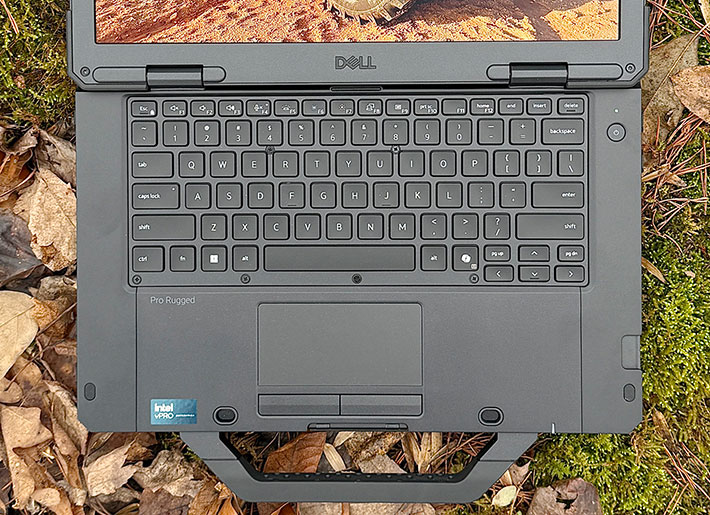
The Rugged 14 has a 4 x 2 inch capacitive touchpad with separate left and right mouseclick tabs below it. The pad area is slightly recessed so that fingers easily sense the perimeter of the pad. The pad surface has a little bit too much stiction for our taste. "Stiction" is defined as "the friction that tends to prevent stationary surfaces from being set in motion." The stationary surface here is the finger, and it takes a bit of force to overcome friction and get the finger moving, rather than just glide away.
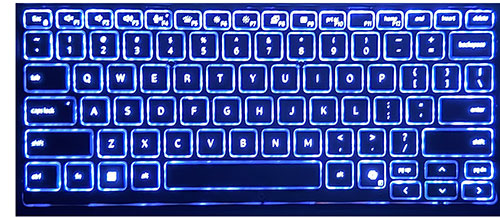 Our review unit had the optional internal-sealed RGB backlight keyboard. The backlight is controlled by one of the function key. Tapping that key toggles the backlight on/off and through three levels of intensity. The comprehensive Dell Rugged Control Center lets you set the keyboard backlight to red, green, blue, white or one of two custom colors. You can also set the default brightness of the keyboard backlight and how long the keyboard should remain backlit when plugged in and when on battery. Our review unit had the optional internal-sealed RGB backlight keyboard. The backlight is controlled by one of the function key. Tapping that key toggles the backlight on/off and through three levels of intensity. The comprehensive Dell Rugged Control Center lets you set the keyboard backlight to red, green, blue, white or one of two custom colors. You can also set the default brightness of the keyboard backlight and how long the keyboard should remain backlit when plugged in and when on battery.
Some keyboard backlights irritate with the illumination bleeding out around the keys in the dark. That's not an issue with the Dell Pro Rugged 14's backlit keyboard; the backlight is designed so that it nicely outlines each key, but does not bleed out beyond.
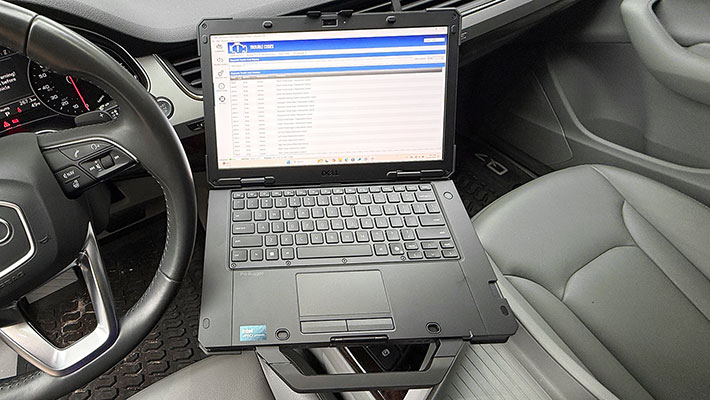
Performance: 14th generation "Meteor Lake" processor technology
Dell sells tens of millions of laptops every year. That sort of volume allows the company to stay on top of the latest technological advances and developments, and quickly make the latest tech available to their customers. One would expect that to be the case for Dell's rugged gear as well, and with the Dell Pro Rugged 14 they did just that. While the predecessor Latitude 5430 Rugged was at the "Tiger Lake" 11th generation of Core processors, the new model takes a three generation leap all the way to the "Meteor Lake" 14th generation Core Ultra.
As of this writing (January 2025), of the major competition in te semi-rugged laptop class, the Panasonic Toughbook 55 Mk3 and the Getac S410 G5 are built around Intel's "Raptor Lake" 13th generation of Core processors, while the Durabook S14I is also using "Meteor Lake" 14th gen chips. So for now, Dell is looking good.
If you're among those still wondering why Intel chips now have two different kinds of processing cores, you're not alone. Here's the deal: With their "Alder Lake" 12th generation of Core processors, Intel introduced so called "hybrid" chips where "Performance" cores did the heavy lifting, and "Efficient" cores handled much of the routine work. That changed their entire chip architecture, and getting it all to work was not easy. A "thread director" had  to preside over what should be sent to the high performance processing cores and what could be assigned to the more basic Efficient cores, relying both on Intel and on Microsoft for thread directing, and only Windows 11 was fully up to that, and not Windows 10. By the 13th generation — named "Raptor Lake" — most issues were worked out. to preside over what should be sent to the high performance processing cores and what could be assigned to the more basic Efficient cores, relying both on Intel and on Microsoft for thread directing, and only Windows 11 was fully up to that, and not Windows 10. By the 13th generation — named "Raptor Lake" — most issues were worked out.
So is the 14th gen even better, with thread directing all nailed down and doing wondrous things? Maybe. Why? Well, turns out the 14th gen of Intel's Core processors comes in two flavors, and the two are barely related. On the one side there is "Raptor Lake Refresh" that presumably makes all the thread directing even better yet. But Intel also went into an entirely different direction, and, thanks to all the attention AI is getting, we now also have "Meteor Lake," and all Meteor Lake-based chips are called "Core Ultra." Below is a table that shows the three Core Ultra processors Dell Pro Rugged 14 customers can pick from (for direct link to the full table, click here):
|
2024 Dell Pro Rugged 14: Available Intel Core Ultra processor options
|
|
Available CPUs
|
Intel Core Ultra i7
|
Intel Core Ultra i5
|
Intel Core Ultra i5
|
|
Model
|
165U
|
135U
|
125U
|
|
Cores/Threads
|
12/14
|
12/14
|
12/14
|
|
Performance Core Base Speed
|
1.70 GHz
|
1.60 GHz
|
1.30 GHz
|
|
Performance Core Turbo Speed
|
4.90 GHz
|
4.40 GHz
|
4.30 GHz
|
|
TDP Base/Max Turbo
|
15/57 watts
|
15/57 watts
|
15/57 watts
|
|
Smart Cache
|
12MB
|
12MB
|
12MB
|
|
Integrated graphics
|
Intel Graphics
|
Intel Graphics
|
Intel Graphics
|
|
Graphics max speed
|
2.00 GHz
|
1.90 GHz
|
1.85 GHz
|
|
Intel Stable Image Platform Program
|
Yes
|
Yes
|
No
|
|
Intel Active Management Technology
|
Yes
|
Yes
|
No
|
|
Intel Trusted Execution
|
Yes
|
Yes
|
Yes
|
|
Intel vPro
|
Yes, Enterprise
|
Yes, Enterprise
|
Yes, Essentials
|
What's different with Core Ultra? For one big thing, it went from 10nm manufacturing down to 7nm. Making things smaller means there can be more transistors/gates in a given area, everything is faster, and it uses less power. And instead of having everything integrated into one big processing die, things are now broken down into separate compute, graphics, SoC, and I/O "tiles". On the graphics side, Iris graphics are gone, replaced by Arc GPUs.
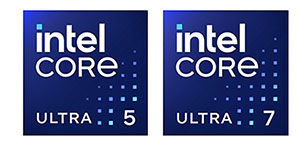 But there's more. With AI — Artificial Intelligence — becoming every more important, "Meteor Lake" processors now also have NPUs — Neural Processing Units. Why? Because "artificial intelligence" workloads are very different from the conventional "if this, then that" sequential processing that works just fine on a small number of cores. AI processing is massively parallel. And hence all Core Ultra chips now also have NPUs, which Intel calls "Intel AI Boost." But there's more. With AI — Artificial Intelligence — becoming every more important, "Meteor Lake" processors now also have NPUs — Neural Processing Units. Why? Because "artificial intelligence" workloads are very different from the conventional "if this, then that" sequential processing that works just fine on a small number of cores. AI processing is massively parallel. And hence all Core Ultra chips now also have NPUs, which Intel calls "Intel AI Boost."
What do they do is not very clear just yet. AI has had an explosive impact on almost everything. So much so that Michael Dell himself in an analyst briefing spoke of "the dawn of the AI-PC" and called it a total revolution. At that same briefing, Dell's Jeff Clarke described the NPU PC as the "beginning of a new era in PCs." While Dell sees itself as a leader in "AI infrastructure," nothing is fully defined yet, nothing is set in stone and everything continues to evolve. What it does mean, though, is that new PCs must be "AI-ready." Clarke said that half of the world's data is created at the edge, and that means that there's lots of local summarization, content creation, translation and the like must be done in mobile systems.
And hence "Meteor Lake" with its NPUs. Intel pretty much had to do it. Because ARM did, and ARM seems ahead. Or else Microsoft and its hardware partners would not have announced a "new category" of ARM-based Windows PCs in 2024. And also because Nvidia is charging ahead with its massively parallel GPUs, threatening to take over in the AI computing realm.
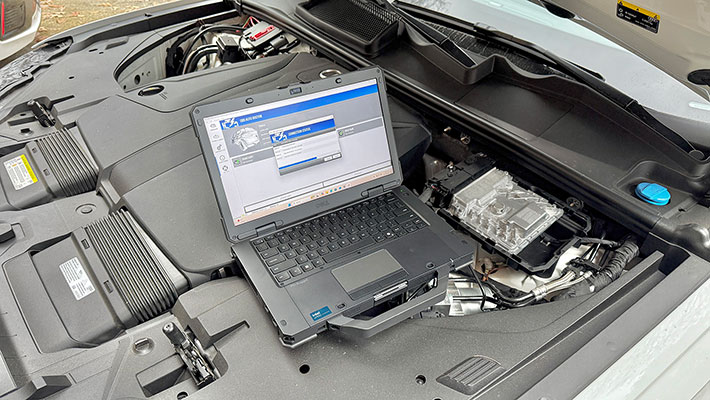
To see what kind of performance the new Dell Pro Rugged 14 delivers with its top-of-the-line Core Ultra i7 165U processor, we ran our standard benchmark suites, Passmark Software's PerformanceTest 6.1 and 9.0 that include dozens of tests covering CPU, 2D graphics, 3D graphics, memory, and disk and then computes scores for each category and an overall PassMark scores. We also ran our old standby, CrystalMark, that provides valuable clues as to overall single core performance. And we ran three other major benchmark suites: PC Mark 10, GeekBench 5, and one of the most often used 3DMark graphics benchmarks, Time Spy.
To show where the Dell Pro Rugged 14 stands in terms of overall performance with just Intel Graphics and also with the optional NVIDIA RTX 500 discrete GPU, the below table also includes results of its Latitude 5430 Rugged predecessor that we tested in 2021, as well as those of the primary direct rugged 14-inch laptop competition.
The results are as follows:
|
Dell Pro Rugged 14 Benchmarks and Comparisons
|
|
Manufacturer
|
Dell
|
Dell
|
Dell
|
Durabook
|
Getac
|
Panasonic
|
|
Model
|
Pro Rugged 14
|
Pro Rugged 14
|
5430 Rugged
|
DURABOOK S14I
|
S410 G5
|
TOUGHBOOK 55 Mk3
|
|
Year tested
|
2024
|
2024
|
2022
|
2021
|
2023
|
2024
|
|
Type
|
14-inch laptop
|
14-inch laptop
|
14-inch laptop
|
14-inch laptop
|
14-inch laptop
|
14-inch laptop
|
|
CPU Type: Intel
|
Core Ultra 7
|
Core Ultra 7
|
Core i7
|
Core i7
|
Core i5
|
Core i7
|
|
CPU Model and generation
|
165U (13th)
|
165U (13th)
|
1185G7 (11th)
|
1165G7 (11th)
|
1350P (13th)
|
1370P (13th)
|
|
Thermal Design Power
|
15/57 watts
|
15/57 watts
|
12/28 watts
|
12/28 watts
|
28/64 watts
|
15/55 watts
|
|
Discrete Graphics
|
NA
|
NVIDIA RTX 500
|
NA
|
NA
|
NA
|
NA
|
|
PassMark 6.1
|
10,201
|
10,265
|
9,848
|
10,339
|
9,503
|
10,714
|
|
PassMark 9.0
|
6,343
|
7,126
|
5,853
|
5,164
|
6,392
|
7,020
|
|
CrystalMark
|
522,901
|
593,308
|
562,890
|
455,646
|
567,465
|
569,420
|
|
PCMark 10
|
5,742
|
7,125
|
5,217
|
4,570
|
5,710
|
5,956
|
|
PCMark 10 Drive
|
2,104
|
2,314
|
2,165
|
4,570
|
1,817
|
2,383
|
|
PCMark 10 Whr/hr
|
9.24
|
12.07
|
7.07
|
10.14
|
9.20
|
8.00
|
|
3DMark Time Spy
|
2,336
|
4,768
|
1,529
|
1,040
|
1,685
|
1,772
|
|
GeekBench 5 Single Core
|
1,769
|
1,765
|
1,566
|
1,496
|
1,622
|
1,833
|
|
GeekBench 5 Multi Core
|
8,787
|
8,848
|
5,232
|
3,640
|
9,136
|
9,723
|
|
GeekBench 5 Open CL
|
19,270
|
63,006
|
14,890
|
12,350
|
16,815
|
17,674
|
The Dell Pro Rugged 14 benchmark results, though clearly impressive, may be slightly disappointing to those who expected the same very large performance increase that the Dell Latitude 5430 Rugged had over the 5420 model. But the 5420/5430 gap was in part due to the 11th generation of Intel Core processors having been a true milestone. The 14th gen chips in the Pro Rugged 14 models, on the other hand, are based on Intel's still relatively new "hybrid" CPU architecture that favors increased versatility and economy of operation, and they are also adding the new NPU core technology to assist with AI-style processing. So not everything may be fully optimized just yet. Overall, though; all Tier 1 "semi-ruggeds" are VERY quick. Small differences here and there may come from slightly different components or from system configuration and the manufacturer's CPU tuning. Overall, the competition here is fierce and most the major players now use the very latest tech.
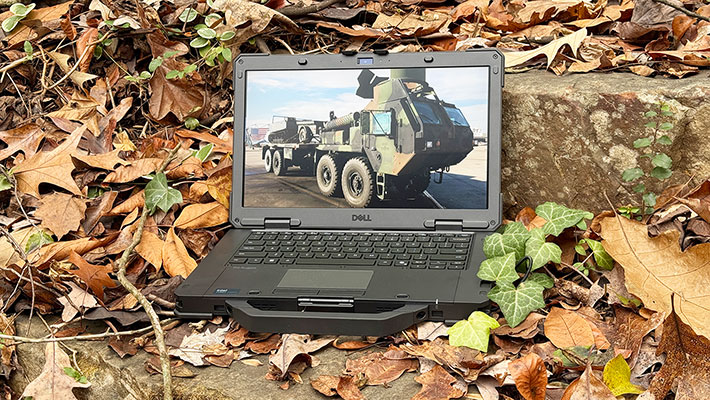
We should bring up here something that generally gets little or no mention in reviews, and that's the difference in performance when a system is plugged in and when it is running on battery.
Benchmark testing is almost always done with computers plugged in. This guarantees consistent results, keep systems from running out of power during a benchmark, and also shows the absolute maximum performance a user can expect from a laptop. Many benchmark tests actually display a warning when one attempts to launch them while on battery.
There are, however, implications of running benchmarks only with systems plugged in. Windows has several settings that affect performance. There are the "Best Performance" and "Best Power Economy" settings in Windows 11. There are various areas in Windows Settings affecting performance where one value is selected for battery and another for when the system is plugged in.
And since the 11th generation of Core processors, Intel has been giving their manufacturing customers the flexibility to tune and configure systems to meet their specific targets. This includes "tuning" performance and economy via power modes to a much larger extent than with earlier Core processors. As a result, ever since the 11th gen, we've been seeing in our benchmark testing often significant differences in system performance under various operating conditions. Specifically, some manufacturers tune for nearly equal performance when plugged in and when on battery. Others emphasize performance when plugged in, and battery life when running on battery. Yet others may feel that there should be maximum performance in the field, even at the cost of battery life.
When we reviewed the Dell Pro 14 Rugged's predecessor, the Dell Latitude 5430 Rugged, it looked like Dell tuned the 5430 to run at maximum performance when plugged in, but very clearly favoring battery life when on battery. In most benchmark tests we ran, the 5430 Rugged was 40 to 50% faster when plugged in than on battery. That is substantial.
How did Dell tune the Pro 14 Rugged for running plugged in and on battery? And does the tuning take the optional Nvidia RTX 500 into consideration? What we found in our testing raises a few questions. While the standard Dell Pro 14 Rugged's PCMark 10 performance on battery was only 5% lower than when plugged in, the RTX 500-equipped machine ran a full 46% faster plugged in than on battery, with battery performance lagging about 10% behind even the standard machine without the GPU. That seems a bit strange.
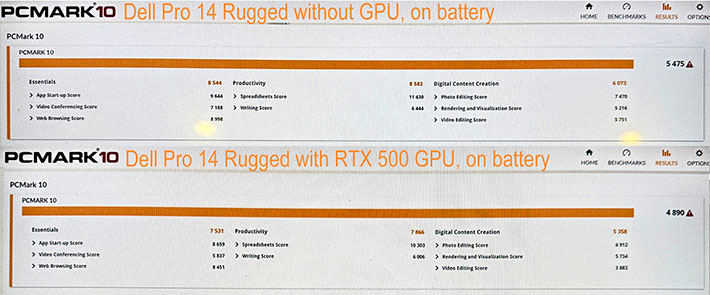
Our testing suggests that the difference between plugged-in and battery performance depends a lot on the type of work. In the also quite demanding PassMark 9 benchmark suite, for example, the Nvidia-equipped machine was overall faster both plugged-in and on battery. However, in both power modes, plugged-in performance was a massive 40% better than on battery.
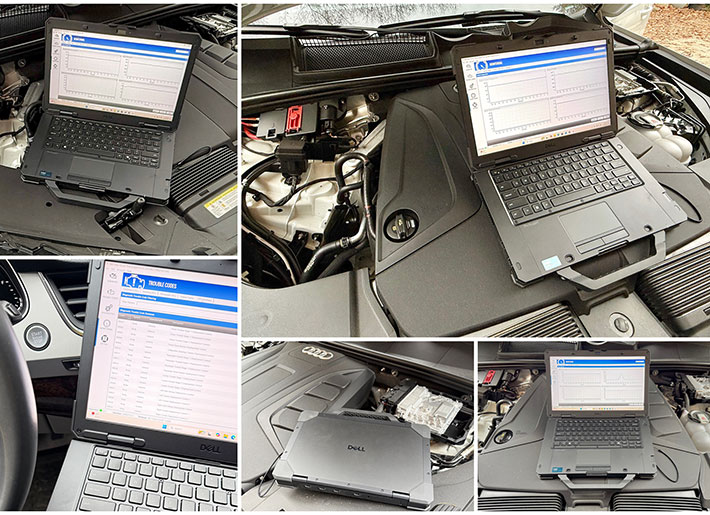
The optional NVIDIA RTX 500 Ada generation laptop GPU
The way it looks right now, it's almost a given that generative AI and hybrid work environments will become ever more common. Which means that computers that can handle that sort of thing will be the norm. Laptops, of course, are designed to be as thin and light as possible, and therefore cannot accommodate the type of big graphics cards that bring superior graphics and, increasingly, AI processing power to desktops. Hence the need for GPU chips that fit right into PCs. It's a concept that goes back to the very start of personal computing, where floating point co-processors were often sitting side by side with the CPU.
And that is where NVIDIA's RTX 500 Ada Generation laptop GPU comes in. It is listed on Dell's website as a $195 option, albeit one reserved for Core Ultra 7 165U equipped systems. The RTX 500 itself is part of an entire NVIDIA lineup of Ada Lovelace architecture-based 1000, 2000, 3000, 3500, 4000 and 5000 Ada Generation Laptop GPUs. According to NVIDIA, those chips include both a neural processing unit (NPU) as well as an NVIDIA RTX GPU, and can add as much as 682 TOPS (TeraOPS, or trillion operations per second) in the RTX 5000, and still a nice 154 TOPS in the RTX 500, of AI performance. For comparison, the Intel Core Ultra chips themselves only generate a fraction of those TOPS figures with their own CPU, graphics and NPU.
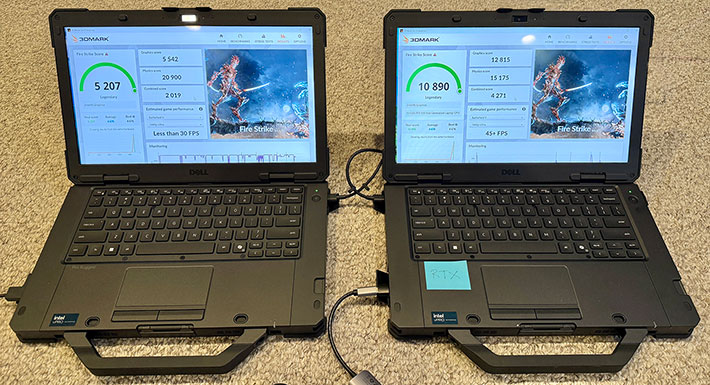
How do such GPU option affect current and emerging real-world work flows? NVIDIA says that the RTX 500 GPU can generate up to 14 times the generative AI performance for models like Stable Diffusion, up to three times faster photo editing with AI and up to ten times the graphics performance for 3D rendering compared with CPU-only configurations. That's substantial. But it does come at a cost: The RTX 500 Ada GPU can be configured to work with as little as 35 to 60 watts — doable in a field laptop — but even the next higher up RTX 1000 Ada may already require 140 watts or more.
|
|
Benchmarks Dell Pro Rugged 14
|
Intel Graphics
|
Nvidia RTX 500
|
RTX 500 faster
|
|
|
3D Mark TimeSpy overall score
|
2,336
|
4,768
|
2.04x
|
|
|
3D Mark TimeSpy graphics score
|
2,083
|
4,691
|
2.25x
|
|
|
3D Mark TimeSpy CPU score
|
7,512
|
5,259
|
0.7x
|
|
|
3D Mark SpeedWay overall score
|
340
|
435
|
1.28x
|
|
|
3D Mark Fire Strike overall score
|
5,207
|
10,890
|
2.09x
|
|
|
3D Mark Fire Strike physics score
|
20,900
|
16,175
|
0.77x
|
|
|
3D Mark Fire Strike combined core
|
2,019
|
4,271
|
2.12x
|
|
|
3D Mark Solar Bay overall score
|
6,811
|
21,568
|
3.17x
|
|
|
3D Mark Solar Bay graphics (fps)
|
25.9
|
82.0
|
3.17x
|
|
|
3D Mark AMD SFR FSR 2 off (fps)
|
6.02
|
15.89
|
2.64x
|
|
|
3D Mark AMD SFR FSR 2 on (fps)
|
10.61
|
28.72
|
2.71x
|
|
|
3D Mark Wild Life overall score
|
10,849
|
28,345
|
2.61x
|
|
|
PassMark 9 3D Graphics score
|
3,376
|
11,371
|
3.37x
|
|
|
GeekBench 5 Open CL
|
19,270
|
63,006
|
3.27x
|
|
|
CrystalMark OGL
|
25,006
|
66,865
|
2.57x
|
|
|
PCMark 10 Battery (watt-hour/hour)
|
9.24
|
12.07
|
0.77x
|
On the storage side, the RTX 500 Ada has 4GB of GDDR6 memory with a peak bandwidth of 128GB/s (the higher-end RTX 1000 Ada has 6GB of memory and can hit 192GB/s). That, NVIDIA, claims is sufficient for so-equipped laptops to "query their internal knowledge base with chatbot-like interfaces using local large language models." Which, depends on just how large such local models can be; cloud-based models are generally huge.
As shown in our benchmark testing (see table to the right), the results of the RTX 500-equipped Dell Pro Rugged 14 were somewhat unpredictable, with some tests showing virtually no difference between our two otherwise identical Dell Rugged 14 models. Generic office workloads showed the least difference, because they generally don't include a lot of graphics processing. Unsurprisingly, dedicated graphics benchmarks showed the most difference, with certain benchmarks running several times faster with the GPU than without. It's safe to say that any customer anticipating a lot of 3D processing will benefit greatly from ordering their Dell Pro Rugged 14 with the Nvidia RTX 500 option.
Overall, looking at the result, it wasn't always easy to figure out what processed where, given that the Dell machines' Core Ultra not only have their own integrated graphics, but also have that Neural Processing Unit. Examining benchmark results and graphs, we saw that the RTX 500 at times lessened the load of the CPU, so that overall benchmarks, even if they were not graphics-oriented, ran faster than on the standard machine without the GPU. It's all a bit of a new world to figure out.
Power draw and battery life
Battery life is one of the most important metrics in a rugged laptop. It can make or break sales. As a result, competition is fierce and the bar for what is acceptable battery life is getting higher and higher. Weight matters in rugged laptops, and that mandates a careful balance between weight and on-board battery power.
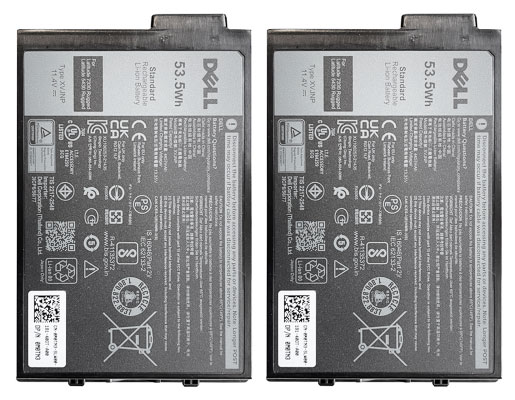 Even though there has been substantial progress in battery energy density, batteries still add weight at a time where customers want their semi-ruggeds as light and handy as possible. The original Dell Latitude 14 Rugged came with a 65 watt-hour or an optional 97 watt-hour battery and had a starting weight of 6.3 pounds. The follow-up Latitude 7420 Rugged switched to the increasingly popular dual battery approach that allows for hot-swapping of batteries and also made for a lower "starting weight" with just one battery; a minimally equipped 5420 started at just 4.9 pounds. The follow-up 5430 used the same approach. It came with one or two 53.5 watt-hour batteries, so users can get an impressive 107 watt-hours. And that hasn't changed with the new Dell Pro Rugged 14. Minimally equipped, weight starts at a, for this class, very low 4.5 pounds. Even though there has been substantial progress in battery energy density, batteries still add weight at a time where customers want their semi-ruggeds as light and handy as possible. The original Dell Latitude 14 Rugged came with a 65 watt-hour or an optional 97 watt-hour battery and had a starting weight of 6.3 pounds. The follow-up Latitude 7420 Rugged switched to the increasingly popular dual battery approach that allows for hot-swapping of batteries and also made for a lower "starting weight" with just one battery; a minimally equipped 5420 started at just 4.9 pounds. The follow-up 5430 used the same approach. It came with one or two 53.5 watt-hour batteries, so users can get an impressive 107 watt-hours. And that hasn't changed with the new Dell Pro Rugged 14. Minimally equipped, weight starts at a, for this class, very low 4.5 pounds.
How does it compare to the competition? Well, Panasonic offers one or two powerful 68 watt-hour batteries in their Toughbook 55 Mk3 that starts at 4.6 pounds. Durabook's S14I can accommodate one or two 50.8 watt-hour batteries and starts at 5.1 pounds. And Getac's S410 also comes with either one or two 74.5 watt-hour batteries, but also has room for a 46.6 watt-hour multimedia bay battery. The S410 starts at 5.25 pounds.
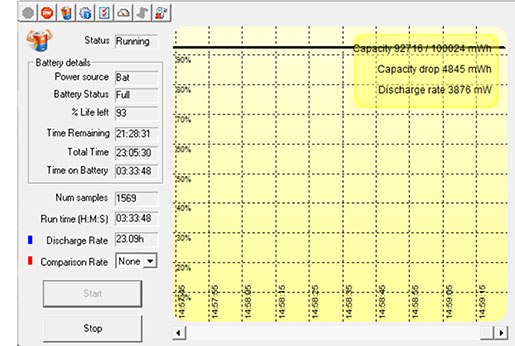 We tested power draw of the Dell Pro Rugged 14 by running our standard BatteryMon benchmark. With the Windows 11 Power Mode set to "Best power efficiency," "Battery Saver" in the Windows task bar clicked on, and the display backlight on its lowest setting, we saw a minimum of about 3.6 watts. That's theoretically good for 26.75 hours with two batteries that provide a combined 107 watt-hours. We tested power draw of the Dell Pro Rugged 14 by running our standard BatteryMon benchmark. With the Windows 11 Power Mode set to "Best power efficiency," "Battery Saver" in the Windows task bar clicked on, and the display backlight on its lowest setting, we saw a minimum of about 3.6 watts. That's theoretically good for 26.75 hours with two batteries that provide a combined 107 watt-hours.
With the backlight set to roughly 50% for comfortable indoor viewing, we saw a minimum of 4.0 watts, theoretically good for 26.8 hours. And with the backlight set to maximum brightness, power draw rose to a minimum of 7.4 watts, theoretically good for 14.5 hours.
|
Dell Pro Rugged 14 BatteryMon Power Draws (at idle)
|
|
Backlight level
|
Darkest
|
50%
|
Brightest
|
|
Max Battery
|
3.6 watts (29.7 hrs.)
|
4.0 watts (26.8 hrs.)
|
7.4 watts (14.5 hrs.)
|
|
Max Performance
|
4.8 watts (22.3 hrs.)
|
5.7 watts (18.8 hrs.)
|
8.4 watts (12.7 hrs.)
|
We then switched the Windows Power mode set to "Best Performance" and "Battery Saver" in the Windows task bar turned off." That way, with the display backlight set to its lowest setting, we saw a minimum of about 4.8 watts. With the backlight set to 50% for comfortable indoor viewing, we recorded 5.7 watts. And with the backlight set to maximum brightness, power draw rose to 8.4 watts, still theoretically good for 12.7 hours.
Real-world mileage will of course vary, as always. Minimum draw in a test lab is not an accurate predictor of actual battery life. Intel's Core processors have become very good at conserving power, to the extent where their recorded "idle" draw is actually often less than that of many Atom processors. Under full load, of course, the powerful Core chip will draw more than the limited Atom CPU.
That's why we also ran the PCMark 10 Battery benchmark. That very comprehensive benchmark continuously runs, in its "Modern Office" mode, everyday applications and types of work at a standardized 200 nits backlight until battery power runs out. Here, equipped with with two batteries, the Dell Pro Rugged 14 managed 8:52 hours with the optional Nvidia RTX 500 GPU, and 11:35 hours without the optional GPU (both extrapolated to 100% battery drawdown). This translates into power consumption of 12.07 watt-hours per hour with the RTX 500, and 9.24 watt-hours per hour without it. The predecessor Dell Latitude 5430 did better here, using just 7.07 watt-hours per hour.
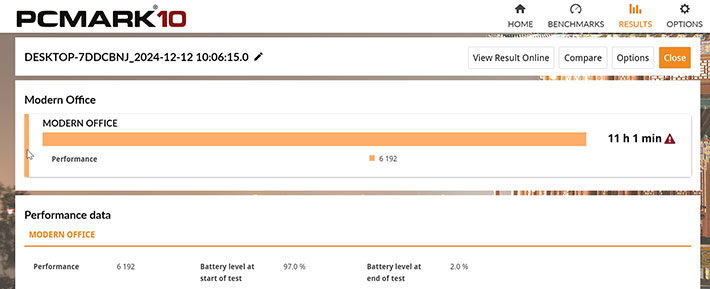
Bright and very good 14-inch display
The Dell Pro Rugged 14's 14.0-inch display is more than large enough to allow working without squinting. Default resolution is 1920 x 1080 pixel. For many years, most semi- and fully rugged laptops came with lower resolution 1366 x 768 displays and full HD wasn't even available for many of them. We're glad those days are gone. The display offers 157 pixel per inch, not "retina" territory but sharp and clear enough.
Touch isn't really needed with a laptop, but with Windows 11 it's increasingly useful and a good thing to have. The laptop's default display doesn't have touch. The brighter outdoor-viewable display option, which both of our test units had, does come with capacitive multi-touch.
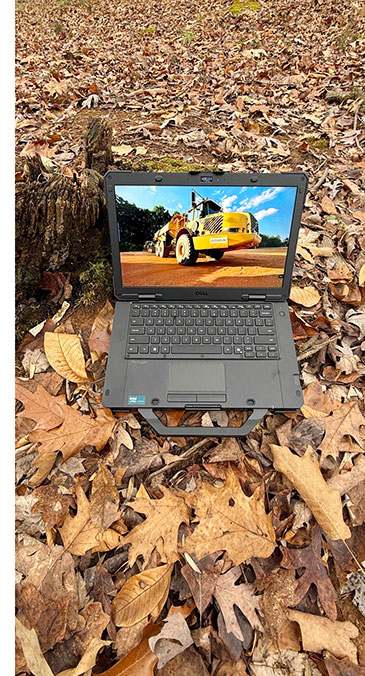 The Dell Pro Rugged 14 display's 16:9 aspect ratio gives the laptop a contemporary look. Interestingly, while the fully rugged fully rugged Pro Rugged 13 and the semi-rugged Pro Rugged 14 are almost identical in look and size, the former's display measures 13.3 inches diagonally and the latter's 14 inches. The only rationale for this we can think of is that with the compact form factor and footprint of the new Pro Rugged 13, there might not have been enough of a bezel to adequately protect a larger 14-inch panel from damage. The Dell Pro Rugged 14 display's 16:9 aspect ratio gives the laptop a contemporary look. Interestingly, while the fully rugged fully rugged Pro Rugged 13 and the semi-rugged Pro Rugged 14 are almost identical in look and size, the former's display measures 13.3 inches diagonally and the latter's 14 inches. The only rationale for this we can think of is that with the compact form factor and footprint of the new Pro Rugged 13, there might not have been enough of a bezel to adequately protect a larger 14-inch panel from damage.
Display size, of course, isn't everything. Semi-rugged notebooks like the Dell Pro Rugged 14 may see a lot of outdoor duty or they may be mounted in vehicles. That means lots of reflections and often direct sunlight. Standard transmissive LCD displays tend to wash out in daylight, and that's why good sunlight-readability has become a selling point with rugged notebooks. The currently most popular way of making a notebook screen readable outdoors combines various optical treatments to control internal reflection with a strong backlight.
A few words about screen brightness here: A standard notebook backlight is in the 200 nits luminance range (1 nit = 1 candela per square meter) range. Some manufacturers up the brightness in their business products, usually into the 300-400 nits range. Industrial monitors used outdoors generally have 400 to 500 nits. High end rugged notebooks offer anywhere from 500 to over 1,000 nits, with premium ones such as the fully-rugged Dell Pro Rugged 13 offering as much as 1,400 nits. The Dell Pro Rugged 14 comes standard with 400 nits display — brighter than a standard consumer laptop, but not bright enough for a lot of outdoor use. And that's why Dell offers an optional 1100 nits touch display. Our test unit had that optional display, though we measured it at just 906 nits in with our own luminance testing equipment.
Very strong backlights, of course, affect battery life. Some of Dell's competitors have dedicated "sunlight readable" buttons to toggle super-brightness on and off. 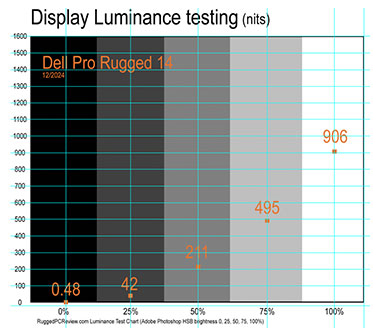 The Dell Pro Rugged 14 doesn't have such a button. So when working with the optional high-bright display in broad daylight, keep an eye on brightness setting. It can make a big difference in battery life. The Dell Pro Rugged 14 doesn't have such a button. So when working with the optional high-bright display in broad daylight, keep an eye on brightness setting. It can make a big difference in battery life.
The Pro Rugged 14 display is what we'd describe as a "semi-gloss" screen. Matte displays are best for eliminating distracting reflections, but they tend to make displays look milky. Full gloss displays, which are pretty much the standard in consumer and business laptops these days, "pop" nicely, but they are prone to strong reflections outdoors. Semi-gloss screens still have some reflections but they are far more muted than those of most consumer laptops and tablets.
Unlike some displays that are fingerprint magnets, the Pro Rugged 14 display is remarkably immune to collecting pesky smudges and fingerprints that quickly cover almost all glossy displays.
Viewing angles are important. Both horizontal and vertical viewing angles of the Dell Pro Rugged 14 screen are very good, without any color shifts even when viewed at extreme angles. About the only change we'd like to see in a future update is — given the increasing emphasis on high-res graphics — a higher resolution display at least as an option.
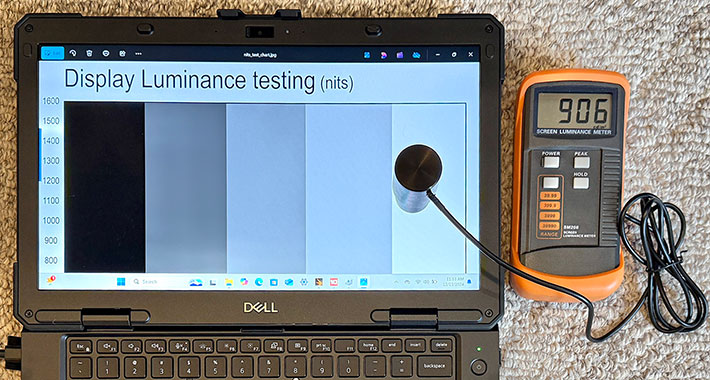
Security
Advanced security has become mandatory for laptops, and especially those likely to be used in enterprise, government and other secure environments. For that the Dell Pro Rugged 14 offers several levels of hardware and software security to prevent unauthorized access as well as theft. Among those are multifactor authentication via passwords, fingerprint reader, contact or contactless Smart Card readers, an IR camera option, as well as Dell's own security tools, data protection/encryption, Dell backup and recovery, and more.
Our system included Intel Trusted Platform Module (TPM) 2.0 hardware security for enhanced boot process integrity, and to create and manage computer-generated digital certificates. Combined with Windows 11 security, it can encrypt biometric data. In addition, TPM can be used to create certificates that can be used to:
- Send and receive secure email,
- Set up the browser for client identification,
- Sign Word macros,
- Encrypt individual files or entire folders, and
- Create secure network connections.
Fingerprint registration software works with the laptop's optional fingerprint scanner that uses capacitive technology so users can just place their finger on the scanner(which is also the power button) rather than swiping.
All of this can get pretty involved. Some users may never implement TPM, fingerprint scanning or even passwords, whereas others may be set up in accordance with their company's IT security procedures, or they may configure an individual system for maximum security.
Over all this, don't forget physical security and get a Kensington locking cable to use with the Kensington slot on the backside of the unit. It is inexpensive insurance against theft.
Additionally, depending on the processor, Dell Pro Rugged 14 Rugged laptops can be configured with Intel vPro, a set of technologies to remotely access and control computers securely. And there's Dell ControlVault, a hardware-based security solution that provides a secure bank that stores passwords, biometric templates, and security codes within the firmware, and also installs pertinent drivers and firmware.
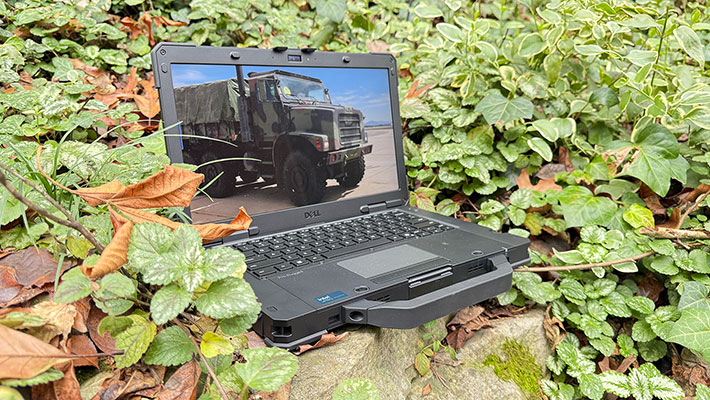
Docking, vehicle mounting, carry bag
Semi-rugged and fully rugged notebooks are often used in vehicles. To that extent, several mounting system specialists offer docks and cradles for Dell's rugged laptops. The Dell Pro Rugged 14 has separate antenna pass-throughs for GPS, WLAN and WWAN. These may be supported by vehicle docks to make roof-mount antennae possible. A set of pogo docking pins on the bottom of the laptop allow the docks to provide port duplication and additional I/O functionality. These can be mounted in numerous ways, using the dock manufacturers' solutions or the vast variety of RAM ball and joint components.

As of this writing (January 2025), Gamber Johnson (above left) offeres a variety of vehicle docking stations for the Dell Pro Rugged 14 with full and "lite" port replication options (including USB-C port), RF or no RF. Havis (above center) also offers a rugged cradle for the Dell Pro Rugged 14 as well as a docking station with standard port or advanced port replication. Precision Mounting Technologies (above right) likewise offers a docking station that works with the Dell Pro Rugged 14.
Below, the super-versatile Dell Rugged Backpack (MSRP $79.99) that offers excellent gear protection in the field for rugged laptops (you can easily fit two), as well as ample extra storage for whatever field accessories users carry along. We loved it.
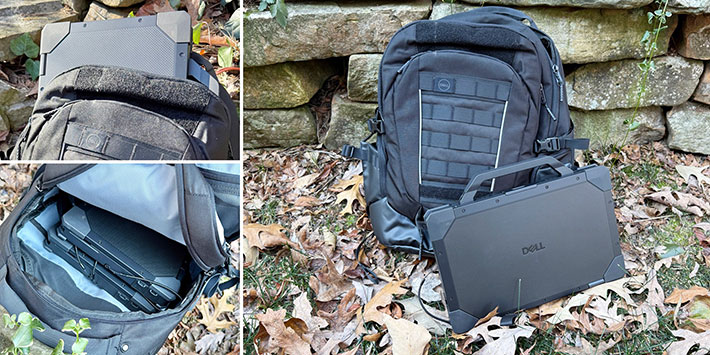
Ruggedness
How tough and rugged is Dell Pro 14 Rugged? As stated earlier, it gets a bit confusing here because while the model's name includes Rugged, it is really a semi-rugged machine. And to reiterate, "semi-rugged" is the rather vague term that describes a degree of robustness that's somewhere between Dell's standard business laptops and the Dell Pro 14 Rugged, the successor to the super-tough Latitude 7330 Rugged Extreme. Whew.
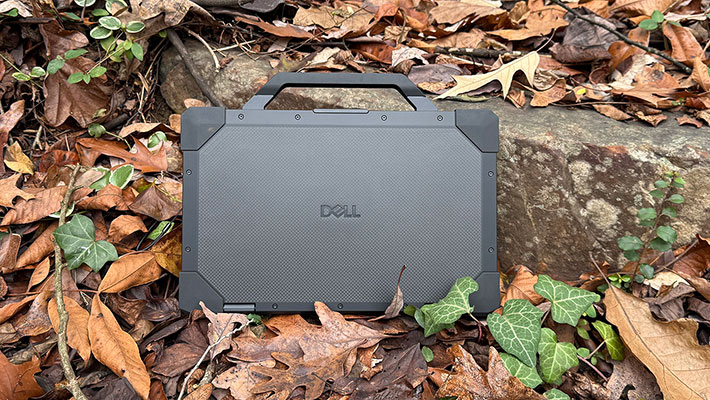
The most likely hazard any laptop is going to encounter is getting dropped. In MIL-STD-810H testing, Dell literature says a Dell Pro 14 Rugged laptop survived 26 three-feet drops while operating. That means a fall from a desk won't faze it whereas such a mishap can kill a lesser laptop. Historically, drop testing has been conducted in accordance with the procedures described in United States military standards. Drops are from a height of 48 inches onto 2-inch plywood over concrete. The machine is then dropped four to six times with the display closed and unit turned off. After each drop, the machine must be able to boot. The relevance of the 4-foot drop is this: when you walk around with a notebook under your arm and you drop it, that's about three feet. 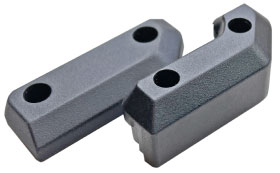 But when you drop it while using it standing up — which almost inevitably happens at some point — that's four feet. We think rugged laptops ought to be certified for four feet, not three. The picture to the right shows the Dell Pro 14 Rugged's (left) and Pro 13 Rugged's (right) protective bumpers. But when you drop it while using it standing up — which almost inevitably happens at some point — that's four feet. We think rugged laptops ought to be certified for four feet, not three. The picture to the right shows the Dell Pro 14 Rugged's (left) and Pro 13 Rugged's (right) protective bumpers.
 Along those lines, a question comes up with both of the newly upgraded laptops. Their protective corner bumpers are screwed on. They could very easily be exchanged with optional heftier bumpers that would instantly provide a lot of extra protection. But no such option is available. Along those lines, a question comes up with both of the newly upgraded laptops. Their protective corner bumpers are screwed on. They could very easily be exchanged with optional heftier bumpers that would instantly provide a lot of extra protection. But no such option is available.
The second important ruggedness consideration is the ability to keep solids and liquids from getting into the machine. That's generally where the Ingress Protection rating comes in. And it's an area where semi-ruggeds differ most from fully ruggeds. Consumer laptops aren't sealed at all. Semi-ruggeds like the Dell Pro 14 Rugged provide more protection. The Pro 14 Rugged carries an IP53 rating, where the "5" means the device is protected against dust, and the "3" that it's also protected against direct sprays of water at up to 60 degree angles from vertical. So it can handle not only the accidental spill but also a good bit of rain and worse.
An important requirement of semi-ruggeds is that they continue to perform at a high level when it's very hot or very cold. The Dell Pro 14 Rugged's operating temperature range is -20 to 145 degrees Fahrenheit. That's very impressive for a machine classified as semi-rugged, and Dell reps say the machine can maintain full performance over the entire range.
What baffles a bit is the dearth of ruggedness information about the Pro 14 Rugged. Even the small print only generally refers to MIL-STD-810H testing for "blowing dust, vibration, functional shock, humidity, altitude, thermal extremes." We know that Dell does extensive ruggedness testing (we've seen it and there's a nice new video about it), but we've been unable to locate detailed ruggedness testing documentation even within Dell's very extensive online product support information.
So things are a bit mixed here. The Pro 14 Rugged is obviously an very well made machine. It's clearly tough, and the supplied ruggedness specs are what we'd expect from a modern semi-rugged. But these machines cost a lot more than standard consumer and customers specifically pay more because they need a ruggedized product. Detailed ruggedness specs that answer all customers' ruggedness questions should be easily available.
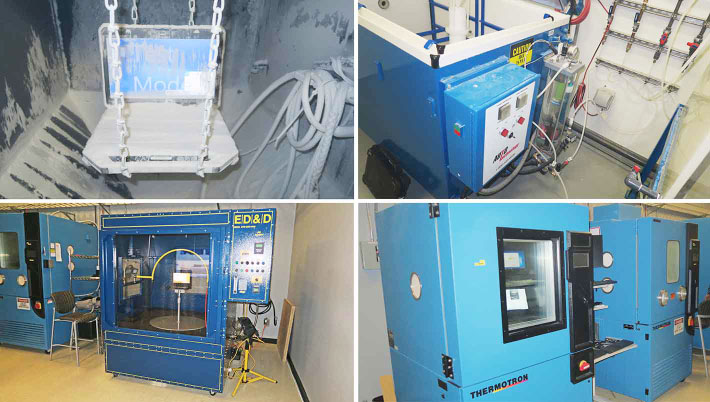
Bottom line: Dell Pro Rugged 14
As standard personal and business laptops get ever thinner and glitzier, there's an increasing demand — particularly in public service and the enterprise — for something that doesn't scratch or break as easily, and provides that extra protection without the high cost of fully rugged gear. That's where "semi-ruggeds" come in. And with the new Dell Pro Rugged 14 — the successor to the Latitude 5430 Rugged — Dell offers a modern, powerful and very convincing semi-rugged laptop.
With a remarkably compact footprint of 13.4 x 8.7 inches, less than an inch and a third thick, and starting out at just 4.5 pounds, customers get a state-of-the-art computing tool perfect for when a regular laptop just isn't tough enough. The 5G-capable and Intel 14th generation Core Ultra processor-powered Pro Rugged 14 has a very reasonable starting price (US$1,969), but adding desirable options can quickly boost the price. But this is a powerful, state-of-the-art and very well made machine that does just about everything right. Equipped with two Thunderbolt 4 USB-C ports, there's little this Dell machine cannot connect to (or getting charged by). The full HD multi-touch display is bright and vibrant, the carry handle just right, and up to 105 watt-hour of battery capacity make for good battery life. The available NVIDIA's RTX 500 Ada Generation laptop GPU option can provide significant extra punch for 3D graphics and, together with the processors' inherent NPU (neural processing unit), emerging AI applications.
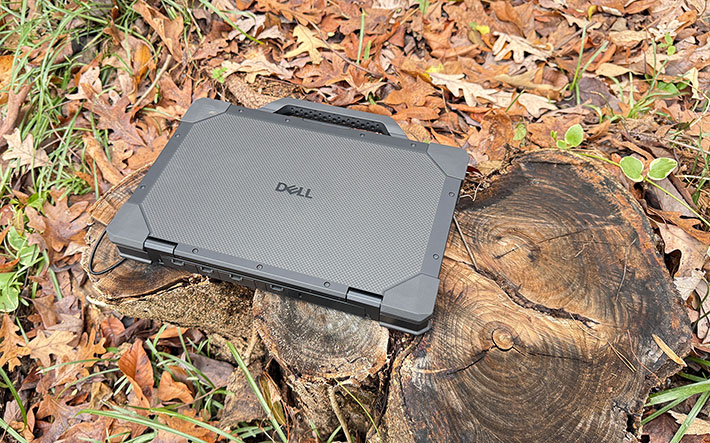
Panasonic, Getac, Durabook and others all offer semi-ruggeds. As of late, there's been an "arms race" with competitors leap-frogging each other with new features and higher performance. With the new Dell Pro Rugged 14, Dell is once again positioned at the leading edge in terms of technology, and the laptop is a bit lighter and more compact than its primary competition.
Dell, of course, is also a world-leading provider of commercial PCs, which gives them an edge in large scale production experience and also with enterprises that like to one-stop shop. In addition, there's Dell's Global Command Center that stays on top of well over 100 million supported systems, millions and millions of annual dispatches and 500+ same day parts centers in over 160 countries, providing 24/7 support in 50+ languages.
Between that, Dell's solid commitment to the rugged space, and the machine's impressive design, up-to-date technology and specs, this new semi-rugged notebook is certain to be a strong competitor. -- Conrad H. Blickenstorfer, January 2025
| Type |
Semi-rugged notebook
|
| Introduced |
Fall 2024, full review January 2025
|
| Processor |
Intel Core Ultra i7 165U (as tested)
Intel Core Ultra i5 135U
Intel Core Ultra i5 125U
|
| Max CPU clock speed |
Core Ultra i7 165U: 4.90 GHz
Core Ultra i5 135U: 4.40 GHz
Core Ultra i5 125U: 4.30 GHz
|
| CPU Smart Cache |
Core Ultra i7 165U: 12MB
Core Ultra i5 135U: 12MB
Core Ultra i5 125U: 12MB
|
| Thermal Design Power |
15/57 watts (all)
|
| Graphics |
Intel Graphics, optional NVIDIA RTX 500, 4GB GDDR6 discrete graphic controller
|
| OS |
Windows 11
|
| Memory |
Up to 64GB non-ECC dual-channel DDR5 5600MHz in two DIMM slots |
| Display |
14.0-inch/1920 x 1080 pixel TFT with semi-matte surface, anti-glare, non-touch, 400 nits; capacitive multi-touch, 1,100 nits (906 as tested) |
| Digitizer |
Capacitive multi-touch technology (with sunlight-readable display option) |
| Keyboard |
82-key full-scale island-style keyboard; optional: RGB backlight, rubberized RGB backlit keyboard.
|
| Storage |
Up to 1TB M.2 2230 PCIe NVMe SSD, Class 35
Up to 256GB self-encrypting M.2 2230 PCIe NVMe SSD, Class 35
Up to 2TB self-encrypting M.2 2280 PCIe NVMe SSD, self-encrypting, Class 40
|
| Expansion slots |
1 x MicroSD Card, optional Smart Card reader
|
| Media Bay |
1 x Micro SD Card, 1 x Nano SIM card; optional Smart card reader, Contactless Smart card reader
|
| Housing |
Magnesium-aluminum
|
| Size |
13.38 x 8.66 x 1.32 inches (340 x 220 x 34 mm)
|
| Weight |
From 4.49 lbs. (2.04 kg) with a single 3-cell battery, no handle; ; weight as tested with handle and two batteries 5.5 lbs (2.50 kg)
|
| Operating temperature |
-20° to 145° Fahrenheit (-29° to 63° C) |
| Ingress protection |
IP53, splash-resistant keyboard
|
| Drop |
MIL-STD-810H 26 x 3-foot, single unit operating drop
|
| Humidity |
95% RH, non-condensing
|
| Other environmental |
Vibration resistant
|
| Power |
3-cell 53.5 Whr Li-Ion battery, optional second 3-cell 53.5 Whr Li-Ion battery supporting hot-swap
|
| Security |
Steel reinforced cable lock slot; optional security includes: Fingerprint reader, Contactless or Contacted SmartCard reader, TPM 2.0, ControlVault advanced authentication, Dell Security Tools, Dell Data Protection | Encryption, NIST SP800-147 secure platform, Dell Backup and Recovery
|
| Camera |
Optional: HD or FHD/IR video front webcam with privacy shutter
|
| Interface |
1 x USB 3.2 Gen 1
1 x USB 3.2 Gen 1 with Power
1 x TB4/USB 3.2 Gen 2 Type-C with Power
1 x RJ45 Ethernet
1 x HDMI 2.0
1 x RS232 serial
1 x headphone & microphone
Opt. 1 x TB4/USB 3.2 Gen 2 Type-C with Power
Opt. I/O bay with RJ-45 OR USB Type-A OR native RS232 OR Fischer USB 3.0
|
| Wireless |
Intel Wi-Fi 6E AX211, 2x2 MIMO, 2400 Mbps, 2.4/5/6 GHz, with optional Bluetooth, OR
Intel Wi-Fi 7 BE200, 2x2 MIMO, 5760 Mbps, 2.4/5/6 GHz, with optional Bluetooth,
Mobile Broadband Options:
Qualcomm Snapdragon X62 5G, Up to 3.5 Gbps OR
Qualcomm Snapdragon SDX12 4G LTE, Up to 600 Mbps
Optional discrete U-BLOX GNSS
|
| Price |
MSRP starting at $1,969 USD |
| Contact |
Dell Pro Rugged 14 web page |
| Contact |
Dell Pro Rugged 14 spec sheet (PDF) |
| Warranty |
Limited Hardware Warranty Standard 3 year Mail-in Service after Remote Diagnosis,
optional 3-5 year Dell ProSupport & ProSupport Plus contracts and optional Next-Business-Day Service available, optional 3-5 year Accidental Damage Service
|
(copyright 2025 RuggedPCReview.com)
|
|
|




